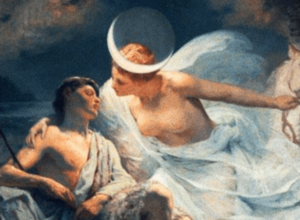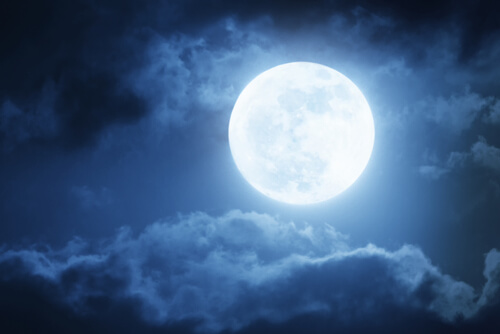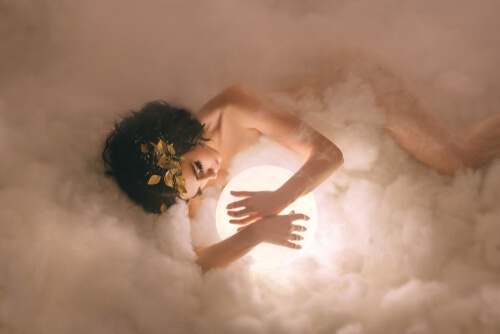The Myth of Selene, Goddess of the Moon

Selene was the goddess of the Moon. While she was of relative importance to the Greeks, she was far more significant to the Romans. She was charged with not leaving mortals in the dark when her brother Helios, the sun, was hidden below the horizon.
Selene is represented as a beautiful woman, with a pale and smooth complexion, who wore a crescent crown on her head. Sometimes, she rode on a bull, but more frequently she was seen riding a silver chariot, drawn by two white oxen or two winged horses. Like Helios did in the daytime, she drove a chariot through the night sky.
The moon goddess always wore white robes and carried a torch in her hand. The myth of Selene had a special influence on the measurement of time among the Greeks. In this society, the months were made up of three periods, each of ten days, in accordance with the phases of the moon.
“There are nights when the wolves are silent and only the moon howls.”
-George Carlin-

The origin of the myth of Selene
The myth of Selene claims that this goddess belonged to the second generation of Titans and was the daughter of Hyperion and Theia. Hyperion was a Titan. As was the case with most Titans, he had no particular role or myth surrounding him, although he was associated with observation or ‘watching from above’.
Theia was both sister and wife of Hyperion and was the Titan goddess of sight. The Greeks believed that the eyes cast rays on objects and it was this that allowed them to see them. One of Theia’s functions was to endow precious metals with their brilliance and value.
Hyperion and Theia had three children: Helios, the sun; Selene, the moon; and Eos, the dawn. Every day Helios was supposed to start a journey across the expanse of the sky. When he finished, darkness came and it was Selene who relieved him to make a similar trip at night. Eos, meanwhile, had the mission of going around the world to announce the presence of Helios every day.
Selene and her great love
The myth of Selene claims that this goddess had several lovers, both divine and mortal. However, her greatest love was a lowly mortal named Endymion. It’s said that he was one of the most beautiful men on Earth, comparable to Adonis or Narcissus.
In mythology, his beauty is explained by indicating that he had the blood of gods, since he was the grandson of Zeus.
Endymion was a shepherd and led his flocks at night. On one occasion, he was on Mount Latmus and felt so tired that he couldn’t help but fall asleep in a grotto. Selene descended to the cave in her chariot and saw the beautiful sleeping shepherd. The site was illuminated with her brightness and he woke up.
Selene didn’t know that Endymion was already in love with her and that he fell asleep every night thinking about the moon. Therefore, when the goddess finally noticed him, the romance was mutual.
However, she was a goddess, therefore immortal, while he was a mere mortal. The myth of Selene claims that she went to ask Zeus for a solution, because she wanted to be with Endymion forever.

Eternal love
Endymion, meanwhile, asked Hypnos, god of sleep, for help. Both Zeus and Hypnos eventually helped them. They couldn’t make the shepherd immortal since this would be the equivalent of giving him the status of a god. Nor could they leave him as an ordinary mortal, since that would afflict Selene.
The solution they found was to leave Endymion asleep. In fact, he could only open his eyes at night to meet Selene. This is how their love story materialized and they went on to have 50 children. They corresponded to the 50 moons or lunar phases that exist in the year.
Nevertheless, according to the myth of Selene, Endymion wasn’t her only lover. With Zeus, she had the beautiful Pandia, goddess of the full moon and the upbringing of children; Ersa, the goddess of morning dew; and Nemea, nymph of a spring of a place with the same name. Some also suggest that, with her brother Helios, she conceived the four Horae or the four seasons.
Greek mythology has beautiful explanations for many natural phenomena. The myth of Selene, the moon goddess, is no exception. Indeed, it reflects the fascinating way the Greeks observed the world and the behavior of nature.
All cited sources were thoroughly reviewed by our team to ensure their quality, reliability, currency, and validity. The bibliography of this article was considered reliable and of academic or scientific accuracy.
- Chaparro Gómez, C. (2000). Mito, texto e imágenes: el mito de Endimión y Selene.
- Noemí, P. (2020). Hijas de Selene. Metaciencia, 29 (3), 457-460.
This text is provided for informational purposes only and does not replace consultation with a professional. If in doubt, consult your specialist.








